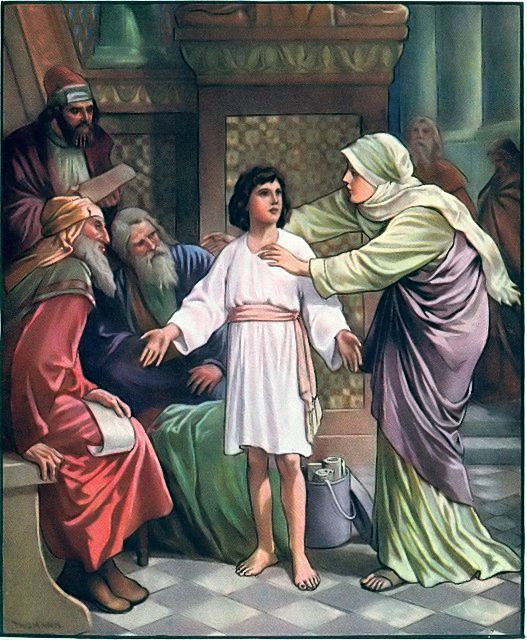A Foreshadowing
by The Rt. Rev. J. Christian Giesler
Assigned texts:
- I Samuel 2:18-20, 26
- Colossians 3:12-17
- Luke 2:41-52
From the 1967 movie “Cool Hand Luke” starring Paul Newman comes one of the most iconic lines cinema history, “What we’ve got here is failure to communicate.” This line is spoken by the “Captain” or prison warden to the captive, “Luke,” just after he lands a blow to Luke’s head with a Billy-stick. The failure to communicate can be found at the core of most of our problems in life, and it certainly is central to what is happening in our Gospel text for today. Here we have the account from Luke of Jesus’ encounter with the religious authorities of the Temple in Jerusalem. While we must all be impressed by Jesus’ knowledge of the sacred texts, we at the same time must scratch our heads as to why Jesus did not communicate with his parents that he wanted to stay behind in Jerusalem for a couple of days.
Let’s look at the context of this text. In Luke’s Gospel, we last saw Jesus as an infant in his parent’s arms returning to Nazareth after their trip to Bethlehem for the taxation registration. We understand, from Luke, that while in Bethlehem, Jesus is born to the virgin Mary and that Angels beaconed the lowly shepherds to drop by for a visit. Luke seems to be unaware or does not care to tell us of the Magi, or the exile to Egypt which made the holy family political refugees for six years, Matthew’s Gospel gives us these details. In Luke, we have this 12-year gap, and the newborn Jesus is now a young adolescent, and in some ways, he is acting like one. We have no idea when Jesus realized just who he was and what God was calling him to be. But it seems as if Jesus is beginning to sense that something is going on inside of him, and he has questions to ask of the leaders of the Temple. Luke does tell us that Jesus and his family made this trip from Nazareth to Jerusalem every year for the Passover, which, taking Luke’s assumptions, means at least 12 times. This was familiar territory for Jesus and his family. They, no doubt, stayed at the same home, ate at many of the same places, and followed a very similar pattern from year to year. After all, most of their schedule was prescribed by the celebration of the Passover festival.
This journey to Jerusalem for the Passover was a priority for all devout Jews, so there was always a large contingent of folks from the Nazareth synagogue that made this journey together. For this reason, it is not surprising that it took Mary and Joseph a full day before they realized that Jesus was not in the caravan. My guess is that they assumed Jesus was with a group of his close friends from home. When they could not find him, they rushed back to Jerusalem and spent three days looking for him, only to find him right back in the Temple, amazing the religious leaders with his questions and understanding of faith.
What we have here is a failure to communicate. I can only imagine the emotions of Jesus’ parents when they first saw him. Luke records Mary saying, “Child, why have you treated us this way.” The accompanying painting of this scene as pictured above captures the moment very well. It is hard to tell whether Mary is reaching out to embrace her son or to wring his neck. Most likely some of both!
The critical question for us here is what does all of this mean? Why does Luke provide us with this picture of Jesus as a youth? For me, I see that Luke is laying some important groundwork about who Jesus is. First, we see that Jesus was a remarkable young teen. None of his peers would have dared to sit with the religious leaders in the Temple as Jesus seems to have done. Luke is telling us that remarkable things are coming from this extraordinary teenager.
Luke also lets us know that even from a young age, Jesus has a relationship with the Temple. He is familiar with its workings, its layout, and the personalities present in it. Since Luke hints that this journey was an annual event, they undoubtedly continued this journey in the years that followed this encounter. At the end of Luke’s Gospel, when at age 33, Jesus returns to Jerusalem for the final time, he is well aware of what he is doing, where he is going, and who runs the show at the Temple. Jesus is no stranger here.
Next, I think it is interesting that Jesus goes missing in Jerusalem for three days. Is this a foreshadowing of his three days in the tomb, again at the end of Luke? I think so. Right up front, Luke lets us know that the infant born at the beginning of this chapter is on a journey to the cross, three days in a tomb, and finally, a resurrection.
Here at Christmas time, it is easy for us to romanticize the scene of a baby born and laid in a manger. Our nativity scenes and Christmas Cards can easily sanitize the story. But Luke quickly tells us that this baby has a mission and a purpose that will transform the world and provide meaning and mission to our lives even today.







